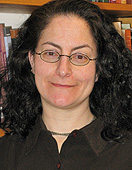Close Up
Gaynor studies enigmatic past of the Sama
-
 Print
Print -
 Comments
Comments
-

“Following a female protagonist…through different versions of the story, then looking at how each one’s reframing fits within different social and historical contexts is very different from how maritime history is usually done.”
Adventure. Intrigue. Romance. Brazen kidnappings and daring escapes on the high seas.
It may sound like the makings of a gripping novel or film, but in fact this historical study of a people spread across a vast archipelago is a story haunted by captivity and the fate of an enigmatic figure of legend.
The Sama are a maritime people—colonial Europeans knew them as nomadic sea gypsies—scattered across island Southeast Asia. Jennifer Gaynor, a historian and anthropologist in the UB Department of History, is in the process of putting her research on their unique history into her first book, which centers on the coasts of Indonesia where numerous Sama people reside.
Like beams of light refracted through water, the different versions of a widespread story about their past have been bent by the circumstances of time and place. Yet, even though they give rise to different views on Sama history, each one focuses on a high-status woman moved from one place to another by sea.
Therein lay the variations on a theme. One version identifies her as a sea gypsy chief’s daughter who, after being kidnapped, escapes and returns to her village, causing the villagers to flee out of fear of revenge by her captors (an explanation for their scattered, nomadic existence).
Other versions peg her as the daughter of a king or a sultan about to be wed when she is kidnapped. More elaborate stories also exist, including longer narratives set down in Bugis-language manuscripts where she is lost at sea in a storm while sailing and washes ashore at a kingdom in Sulawesi, brought up to the raja’s castle and eventually married into the family. Still another version puts her within the romantic sweep of the Sleeping Beauty tale.
In her ethnographic fieldwork, Gaynor frequently encountered variants of this story from the Sama, who traced their own descent through the high-status lineage of this enigmatic female protagonist, often known as Putri Papu—“Papu’s (royal) daughter.”
“It’s so important to them that there’s a kind of restricted access, not only to the manuscripts that they occasionally keep as heirlooms but also just to the knowledge of the story itself,” says Gaynor, assistant professor in the Department of History. “People would give me this look and sometimes say to me, ‘Do you have some Sama descent in you that you know this particular story?’ It was a kind of moment typical in stories about anthropological fieldwork where the researcher gets accepted, but also was a sign of the story’s value—the way it was treated by the people who knew it.”
Gaynor notes that is possible to read a kind of cultural history from the differences between the stories. “It has to do with the importance of capture—the historical commonality of capture among these coastal people—and the importance of being able to have a high-status lineage that you can point to at the same time.”
She compares this sort of story to that of Homer in the Greek tradition. “A lot of Greek history books will start with Homer, even though most historians of Greece will note that there is something legendary about Homer that you cannot pin down. These manuscripts do a similar thing. They’re about the Sama past and they start with this story about a legendary figure.”
Gaynor points out that these stories make it possible to see the social settings they depict in terms that now would be called transnational. “These are stories that have complex social-ethnic interactions across a very large space and the people in them are anything but isolated,” she explains. “They are intimately wound up with the most international networks and trades. The spice trade itself started from the eastern end of the archipelago. Nutmeg and cloves are native to the Maluku islands and were transshipped across island Southeast Asia and the Indian Ocean centuries before Europeans got into the trade, the impetus for the Age of Sail—or what should perhaps be called the European, or Euro-American, Age of Sail.”
Maritime history has long been an interest of Gaynor’s. She has met with these stories of the Sama and their maritime past in colonial archives, travel literature, Bugis-language manuscripts, ethnographic fieldwork and scholarly literature. She has even interviewed a Sama woman, supposedly a lineal descendant of the legendary figure, who had actually been kidnapped during an Islamist rebellion in 1950s Indonesia.
“It’s a complicated story to tell,” Gaynor says. “Following a female protagonist—not very common in maritime history—through different versions of the story, then looking at how each one‘s reframing fits within different social and historical contexts is very different from how maritime history is usually done.”
Gaynor, who joined the UB faculty in 2007, currently is on a Humanities Institute fellowship as she authors this unique historical work on “Intertidal History, Submerged Genealogy, and the Legacy of Coastal Capture in Island Southeast Asia.” She also is completing an article for an upcoming piracy-themed issue of Anthropological Quarterly, which serves as some of the subject matter for her second book and builds on an “International Piracy” course that she co-taught in the Law School.
She will deliver a sampling of Sama stories in a talk entitled “Indonesian Captivity Narratives” as part of the Humanities Institute’s Scholars at Hallwalls series. The talk will take place at 4 p.m. Nov. 18 in Hallwalls Contemporary Arts Center.
Gaynor resides in Kenmore with her husband, Joshua Coene, who is finishing his dissertation on transnational prison history at the University of Michigan-Ann Arbor, and their 3-year-old son, Maxwell.

Reader Comments